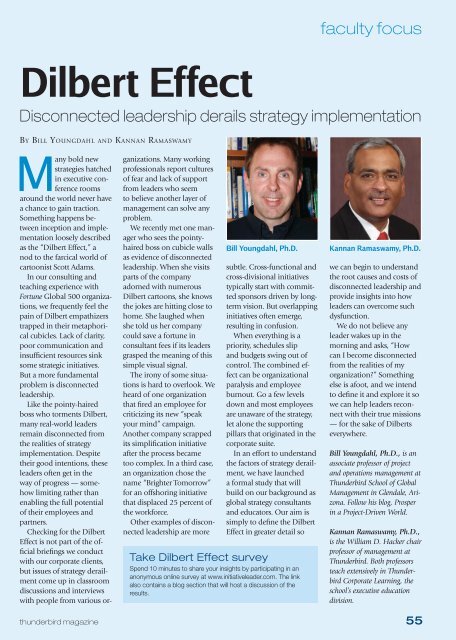Spring 11 MASTER.indd - Thunderbird Magazine
Spring 11 MASTER.indd - Thunderbird Magazine
Spring 11 MASTER.indd - Thunderbird Magazine
Create successful ePaper yourself
Turn your PDF publications into a flip-book with our unique Google optimized e-Paper software.
faculty focus<br />
Dilbert Effect<br />
Disconnected leadership derails strategy implementation<br />
BY BILL YOUNGDAHL AND KANNAN RAMASWAMY<br />
Many bold new<br />
strategies hatched<br />
in executive conference<br />
rooms<br />
around the world never have<br />
a chance to gain traction.<br />
Something happens between<br />
inception and implementation<br />
loosely described<br />
as the “Dilbert Effect,” a<br />
nod to the farcical world of<br />
cartoonist Scott Adams.<br />
In our consulting and<br />
teaching experience with<br />
Fortune Global 500 organizations,<br />
we frequently feel the<br />
pain of Dilbert empathizers<br />
trapped in their metaphorical<br />
cubicles. Lack of clarity,<br />
poor communication and<br />
insufficient resources sink<br />
some strategic initiatives.<br />
But a more fundamental<br />
problem is disconnected<br />
leadership.<br />
Like the pointy-haired<br />
boss who torments Dilbert,<br />
many real-world leaders<br />
remain disconnected from<br />
the realities of strategy<br />
implementation. Despite<br />
their good intentions, these<br />
leaders often get in the<br />
way of progress — somehow<br />
limiting rather than<br />
enabling the full potential<br />
of their employees and<br />
partners.<br />
Checking for the Dilbert<br />
Effect is not part of the official<br />
briefings we conduct<br />
with our corporate clients,<br />
but issues of strategy derailment<br />
come up in classroom<br />
discussions and interviews<br />
with people from various organizations.<br />
Many working<br />
professionals report cultures<br />
of fear and lack of support<br />
from leaders who seem<br />
to believe another layer of<br />
management can solve any<br />
problem.<br />
We recently met one manager<br />
who sees the pointyhaired<br />
boss on cubicle walls<br />
as evidence of disconnected<br />
leadership. When she visits<br />
parts of the company<br />
adorned with numerous<br />
Dilbert cartoons, she knows<br />
the jokes are hitting close to<br />
home. She laughed when<br />
she told us her company<br />
could save a fortune in<br />
consultant fees if its leaders<br />
grasped the meaning of this<br />
simple visual signal.<br />
The irony of some situations<br />
is hard to overlook. We<br />
heard of one organization<br />
that fired an employee for<br />
criticizing its new “speak<br />
your mind” campaign.<br />
Another company scrapped<br />
its simplification initiative<br />
after the process became<br />
too complex. In a third case,<br />
an organization chose the<br />
name “Brighter Tomorrow”<br />
for an offshoring initiative<br />
that displaced 25 percent of<br />
the workforce.<br />
Other examples of disconnected<br />
leadership are more<br />
Bill Youngdahl, Ph.D.<br />
subtle. Cross-functional and<br />
cross-divisional initiatives<br />
typically start with committed<br />
sponsors driven by longterm<br />
vision. But overlapping<br />
initiatives often emerge,<br />
resulting in confusion.<br />
When everything is a<br />
priority, schedules slip<br />
and budgets swing out of<br />
control. The combined effect<br />
can be organizational<br />
paralysis and employee<br />
burnout. Go a few levels<br />
down and most employees<br />
are unaware of the strategy,<br />
let alone the supporting<br />
pillars that originated in the<br />
corporate suite.<br />
In an effort to understand<br />
the factors of strategy derailment,<br />
we have launched<br />
a formal study that will<br />
build on our background as<br />
global strategy consultants<br />
and educators. Our aim is<br />
simply to define the Dilbert<br />
Effect in greater detail so<br />
Take Dilbert Effect survey<br />
Spend 10 minutes to share your insights by participating in an<br />
anonymous online survey at www.initiativeleader.com. The link<br />
also contains a blog section that will host a discussion of the<br />
results.<br />
Kannan Ramaswamy, Ph.D.<br />
we can begin to understand<br />
the root causes and costs of<br />
disconnected leadership and<br />
provide insights into how<br />
leaders can overcome such<br />
dysfunction.<br />
We do not believe any<br />
leader wakes up in the<br />
morning and asks, “How<br />
can I become disconnected<br />
from the realities of my<br />
organization?” Something<br />
else is afoot, and we intend<br />
to define it and explore it so<br />
we can help leaders reconnect<br />
with their true missions<br />
— for the sake of Dilberts<br />
everywhere.<br />
Bill Youngdahl, Ph.D., is an<br />
associate professor of project<br />
and operations management at<br />
<strong>Thunderbird</strong> School of Global<br />
Management in Glendale, Arizona.<br />
Follow his blog, Prosper<br />
in a Project-Driven World.<br />
Kannan Ramaswamy, Ph.D.,<br />
is the William D. Hacker chair<br />
professor of management at<br />
<strong>Thunderbird</strong>. Both professors<br />
teach extensively in <strong>Thunderbird</strong><br />
Corporate Learning, the<br />
school’s executive education<br />
division.<br />
thunderbird magazine 55

















